In 1921, 23-year-old seamstress Ada Blackjack embarked on an expedition to a remote Siberian island with four white men. They would face -50 degree temperatures, starvation, bears and scurvy. Only one of them made it home.
![Ada Blackjack pictured on Wrangel Island with her expedition teammates and the expedition cat, Vic [Creative Commons]](https://www.aljazeera.com/wp-content/uploads/2021/05/1921_Wrangel_Island_Expedition_teamCOURTESY-CREATIVE-COMMONS.jpeg?resize=770%2C513)
As well as being a prime spot for fur trapping and walrus hunting – both profitable industries – Vilhjalmur saw the potential for a future airbase on the island, which could aid his search for the uncharted northern continent he was convinced existed. For the young, adventure-seeking explorers recruited, the prospect of being involved in such a mission was too great to refuse.
The plan was for the team to stay there for up to two years, with a supply ship scheduled to arrive after a year. Ada, a 23-year-old Iñupiat woman, would be their seamstress, sewing fur clothing to withstand the Arctic temperatures.
The only problem was that she did not want to be there, but by then it was too late. Behind her, the Silver Wave – the ship they’d arrived on and her sole connection to home – drifted towards the horizon as her eyes filled with tears.
“When we got to Wrangel Island, the land looked very large to me, but they said that it was only a small island,” said Ada in a statement published in Vilhjalmur’s book, Adventure of Wrangel Island, four years later in 1925. “I thought at first that I would turn back, but I decided it wouldn’t be fair to the boys.”
Gold, death and poverty
Ada was born in the remote Inuit settlement of Spruce Creek, northwest Alaska, in 1898, the year of the Alaskan Gold Rush.
When gold was discovered in the nearby village of Solomon, 13km (eight miles) west of Spruce Creek, the region saw an influx of thousands of non-Native people from across the US. Infrastructure followed, including a railroad and telephone line, but when tidal storms hit in 1913, the railroad was destroyed and – with the Gold Rush over – Solomon became a predominantly Iñupiat village once again. In 1918, the area was ravaged by the Spanish flu epidemic which wiped out over half of Solomon’s 62 residents.
Ada’s family endured their own personal tragedy. When she was eight years old, her father died after eating spoiled meat. After his death, her mother sent her to a Methodist school run by Christian missionaries in Nome, another nearby gold rush town. There, she was taught to read in English, sew and cook “white folk’s food”. Such schools often forcibly removed Indigenous children from their families, communities and cultures, punishing them for speaking their Native languages and practising their beliefs.
At 16, Ada married a local dog musher, Jack Blackjack, and they lived together on the Seward Peninsula, 64km (40 miles) away from Nome. They had three children, but only one survived infancy. According to Jennifer Niven’s book, Ada Blackjack: A True Story of Survival in the Arctic (2003), which is based on Ada’s journals and interviews with her son, Jack beat and starved Ada.
In 1921, when she was 22, Jack deserted her. Poverty-stricken, she walked with her then five-year-old son, Bennett, who was ill with tuberculosis, from the Seward Peninsula back to Nome. When Bennett got too tired to walk, she carried him.
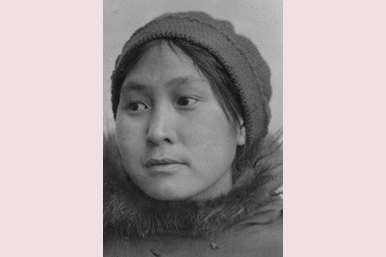 A portrait of Ada Blackjack [Creative Commons]
A portrait of Ada Blackjack [Creative Commons]Once she returned, Ada was forced to leave Bennett in the care of an orphanage, as she could no longer afford to raise him on her meagre earnings from housekeeping and sewing. It was around this time that an expedition crew arrived in Nome seeking a seamstress who spoke English. Ada’s name was immediately put forward by the local police chief.
The proposal daunted Ada, who was reluctant to leave her ailing son. She also did not want to be the only Iñupiat on the voyage, but the team was persistent and assured her there would be other Inuit families going too. Such expeditions relied on skilled Inuit for their knowledge of the land and hunting abilities, which were often critical to their survival in the polar regions. If Ada went, they promised her a salary of $50 a month, which was far more than she’d make in Nome and possibly enough to get Bennett the medical treatment he desperately needed.
On September 9, 1921, the four members of the Wrangel Island expedition – including 20-year-old Canadian Allan Crawford, who was appointed as the expedition leader, Lorne Knight and Fred Maurer, both 28-year-old Americans and veterans of Vilhjalmur’s previous Arctic voyages, and 19-year-old American Milton Galle – prepared to set sail from Nome – a journey of approximately 1,000km (620 miles), which would take a week.
Ada arrived at the port, only to find that none of the other Inuit families had turned up. The men reassured her that they would hire some en route, but when they reached Wrangel a week later, via East Cape, Siberia, Ada was the sole Inuit member of the team and the only woman. After writing their final letters home, the mail was loaded onto the Silver Wave before the captain made his return to Nome.
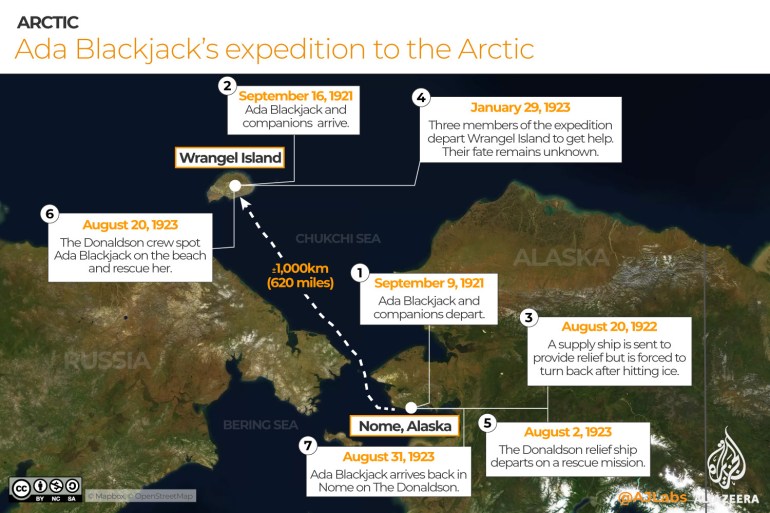
The ‘frost-killed end of creation’
Located 140km (87 miles) off the northeastern coast of Siberia and bordered by the East Siberian and Chukchi Seas, Wrangel Island is the epitome of remote. During a brief visit in 1881, naturalist John Muir referred to it as a “severely solitary” land in the “topmost, frost-killed end of creation”. It is thought that 4,000 years ago, Wrangel was one of the last outposts for the now-extinct woolly mammoth, until their isolation ultimately led to their demise.
It was summer when Vilhjalmur’s expedition team landed, though the temperature hovered just above freezing. Howling winds raked across the tundra where pink flowers clung stubbornly to the rocky terrain. One person among the group had been here before. In 1913, Fred had accompanied Vilhjalmur on the doomed Karluk expedition in which 11 explorers died after their boat sank, leaving them stranded on the ice. If it was cold now, Fred knew first-hand just how hostile the island would become in winter, which would soon be upon them.
The group worked for 16 hours straight setting up camp, pitching three tents – one for their living quarters and two for supplies. But they soon discovered that their supplies, which were supposed to last them six months, were in poor condition; some of the food had turned rotten and other items had not made the trip at all. The seven dogs they’d purchased in Nome were underweight and malnourished. Nobody was too concerned though, because Vilhjalmur had told the young men that the “friendly Arctic” would provide all they needed. It did not seem to matter to him that none of them knew how to handle a gun properly, even though they were expected to kill their own game.
Once the camp was established, the men spent their days exploring the island, carrying out scientific work and studying the wildlife while fervently documenting everything in their journals. Ada, meanwhile, sewed, cooked, cleaned and scraped animal skins. It was a lonely existence, worsened by her fear of one of the men – Lorne, who was particularly large and referred to Ada only as “the woman”.
As the weeks passed, however, the group began to bond and came to rely on each other for companionship in the increasingly hostile conditions. One group portrait shows them huddled together, their faces haloed by their fur hoods and hardened by the cold. On Milton’s lap sits Vic, the expedition cat, who was gifted to them by the chief steward of the Victoria, the boat which had carried the crew from Seattle to Nome, before they picked up Ada.
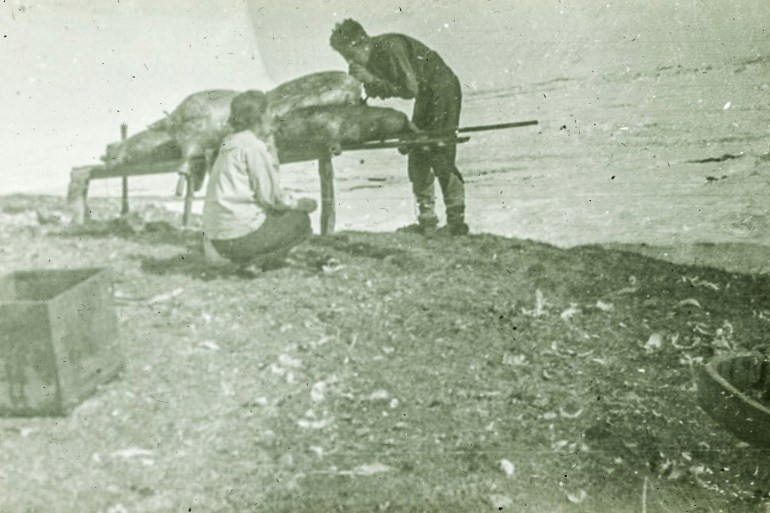 Ada Blackjack watching Crawford inflating skin bags [Courtesy of Dartmouth College Library]
Ada Blackjack watching Crawford inflating skin bags [Courtesy of Dartmouth College Library]The men tried hunting, but the umiak (a boat made from animal skins) they had purchased before the voyage had been lost on the journey, washed overboard during a storm. Instead, they experimented with traps and subsisted on sporadic catches of foxes, fish, birds and seals. Occasionally, they caught polar bears, which are prevalent on the island, Wrangel having the highest density of polar bear dens in the world. But the bears also stalked them.
It was a brutal winter; storms raged incessantly across the island and blizzards made hunting near impossible. Yet they still managed to celebrate Christmas and the New Year in relative comfort and good spirits.
Meanwhile, Vilhjalmur – who was broke – urgently tried to appeal to the Canadian government for funds to support a relief mission, but trust in the explorer had waned since the disastrous 1913 Karluk expedition. Not only was the government unwilling to help him, but the British now claimed it had no interest in colonising Wrangel.
Vilhjalmur knew that unless he acted quickly, the ice would soon be impassable, meaning the group would be stuck on the island.
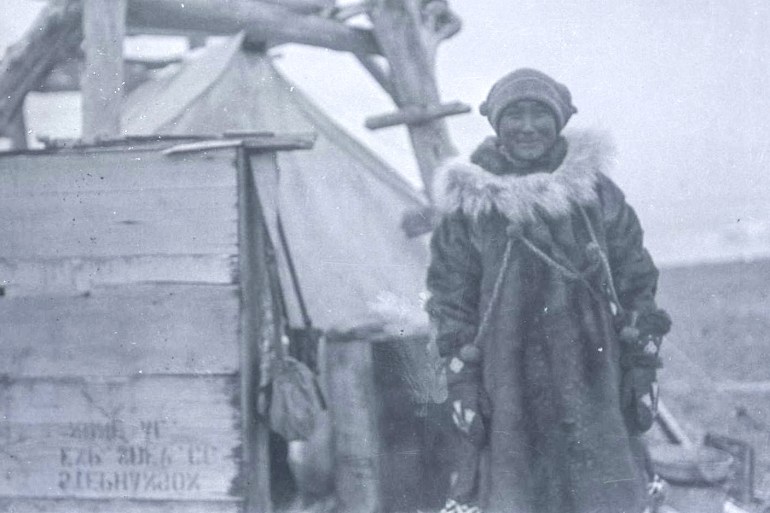 Ada Blackjack at her tent surrounded by supplies [Courtesy of Dartmouth College Library]
Ada Blackjack at her tent surrounded by supplies [Courtesy of Dartmouth College Library]‘Doctor, nurse, companion, servant and huntsman’
Meanwhile, on the island, as the months passed and supplies were almost exhausted, Ada and the four men awaited the relief crew that was due to arrive in the summer of 1922. But each day as they looked towards the horizon hoping to see the masts of a ship, their hearts sank; the ice, which began to form in August, became impenetrable and by mid-September, they finally accepted that no ship would be able to break through. Faced with the likelihood of spending another year on the island, the group began frantically rationing food and supplies.
Unknown to them, a ship – the Teddy Bear – had in fact left Nome on August 20, 1922. It was steered by one of the most experienced Arctic navigators – Captain Joe Bernard, a French Canadian who spent decades sailing the Arctic and living among Native Inuit communities – but, due to the severe icy conditions, passage to Wrangel was impossible and it was forced to turn back.
On the island, the situation had grown desperate. Food was scarce. Foxes were elusive yet their visible tracks in the snow now seemed to taunt them.
“[Ada] and the others had counted on the fact that the bears, seals, and foxes would remain thick. They didn’t know that sometimes the animals simply chose to frequent another location from year to year, and that there was a domino effect in place – because the seals were gone, the polar bears must look elsewhere for food,” wrote Niven.
As if things weren’t bad enough, Lorne had fallen ill with scurvy, a disease caused by a deficiency of vitamin C.
Allan and the others decided they must take action. On January 29, 1923, Allan, Fred and Milton left camp. Their plan was to cross the 1,127km (700-mile) frozen Chukchi Sea to East Cape, Siberia by sledge for help and food, leaving Ada behind to care for Lorne. They expected the journey to take 60 to 70 days. As they bade farewell, they promised to return with a ship in the summer as soon as the ice opened up.
By that point, Lorne was growing so weak he could no longer write in his journal so Ada began keeping one herself, carefully recording the daily events. “I’m going to the other side of the harbar mouth do some duck hunding,” she wrote in one entry. “I thank god for living,” read another.
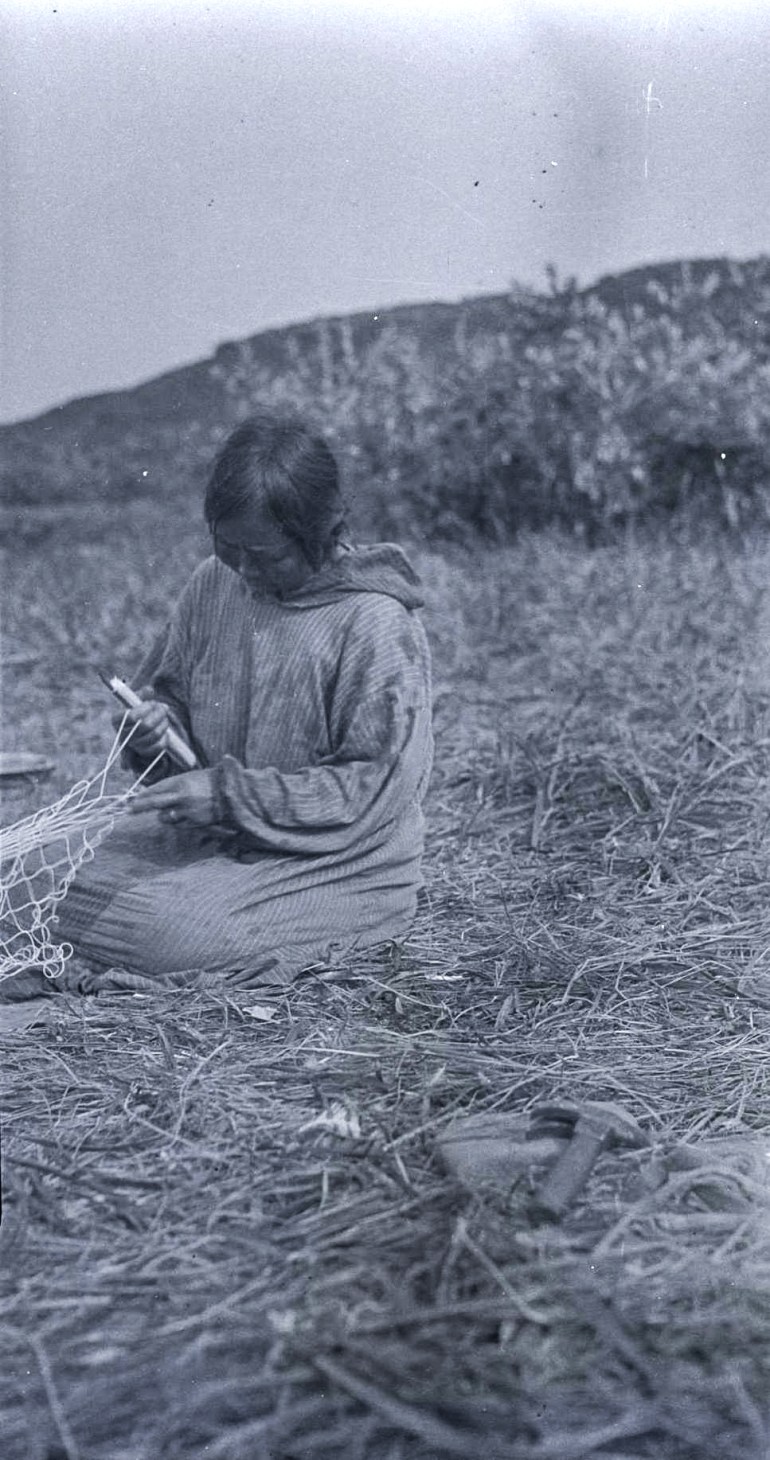 Ada Blackjack tying a fishing net [Courtesy of Dartmouth College Library]
Ada Blackjack tying a fishing net [Courtesy of Dartmouth College Library]But no matter how hard she worked, Lorne grew increasingly impatient with Ada as his symptoms worsened. He berated her, telling her she was lazy, useless, that Jack Blackjack was right to abuse her. Sometimes he threw books at her.
“This is the wosest life I ever live in this world,” Ada confided in her diary. “Though it is hard enough for me to wood work and trying my best in everything and when I come home to rest here a man talk against me saying all kinds of words against me then what could I do.”
Still, she continued to care for Lorne, heating sand every day to place on his feet, rotating sacks of oatmeal to prevent bedsores, emptying his bedpan and keeping the fire going – even as, by early 1923, she too was experiencing the body aches, fatigue and weakness of early-onset scurvy.
Lorne started to bleed from his skin and nose, his teeth loosened, he lost his appetite and purple spots started to appear on his legs. Ada served as a “doctor, nurse, companion, servant and huntsman in one”, reported the Los Angeles Times in 1924 about her role in the Wrangel Expedition.
In her diary, Ada wrote of Lorne: “He never stop to think how much its hard for women to take four mans place, to wood work and to hund for something to eat for him and do waiting to his bed and take the shiad out for him.”
Despite the friction between them, the pair shared stories to pass the time and Lorne gave Ada his Bible, which she often read with Vic curled up next to her.
But on June 22, 1923, Lorne died following a gruelling six months of agony, and Ada was left alone on Wrangel Island.
 Ada Blackjack by one of the camp tents [Courtesy of Dartmouth College Library]
Ada Blackjack by one of the camp tents [Courtesy of Dartmouth College Library]‘I must stay alive. I will live’
Following Lorne’s death, Ada built a barricade of boxes around his bed to protect his body from wild animals and then moved into the storage tent with Vic. All the time, she thought of Bennett and knew she must focus her energy on staying alive. “I must stay alive,” Ada wrote in her journal. “I will live.”
Although it had been nearly two years since she had arrived on the island, Ada never gave up hope that one day she would return to Nome and be reunited with her son. “I don’t think I could have pulled through if it hadn’t been for thoughts of my little boy at home,” she later told the Los Angeles Times. “I had to live for him.”
What she did not know then was that on August 2, 1923, a ship called The Donaldson had set sail from Nome, led by Vilhjalmur’s colleague, Harold Noice. Accompanying him were 12 Inuit and an American.
When it arrived at Wrangel on August 19, Harold feared the worst. “It seemed to us that no human being could find a foothold, let alone a living in such a desolate place,” he said, according to Niven.
Then, on August 20, a figure was spotted on the beach: a woman.
Overnight, Ada had dreamt of a ship, but when she woke she found that a dense fog had descended.
Huddling beside the fire with a breakfast of tea, seal oil and dried duck, she felt a tremor beneath her feet and an ominous rumbling sound from outside the tent. At first, she assumed it was a walrus but, gradually, it grew louder. Stepping outside, Ada peered through the fog with her field glasses and as the fog shifted, she glimpsed the unmistakable outline of a ship. Ada was not dreaming; finally, she was going home.
Ada’s return to Nome on August 31, 1923, caused a sensation in the news. The international press called her the “female Robinson Crusoe”, but Ada did not regard herself as a hero. “Brave?” she’d say. “I don’t know about that. But I would never give up hope while I’m still alive.”
Others, such as her rescuer Harold, who was in possession of her journals, twisted her words and accused her of neglecting Lorne – essentially leaving him to die – which stung the most considering all she had done for him. “Though Man’s Body Was Wasted by Starvation, Ada Blackjack Was Healthy,” ran one headline. “Lorne Knight’s Fate Could Have Been Prevented by Reputed Heroine, Rescuer Says,” said another.
Though she refused to speak to journalists, Ada did grant an interview in February 1924 to the Los Angeles Times in response to the allegations made against her. “For two months I was alone on the island,” she said. “It was hard. But these accusations are harder still. There is no truth to them.” The more she was hounded by reporters, the more she longed to retreat.
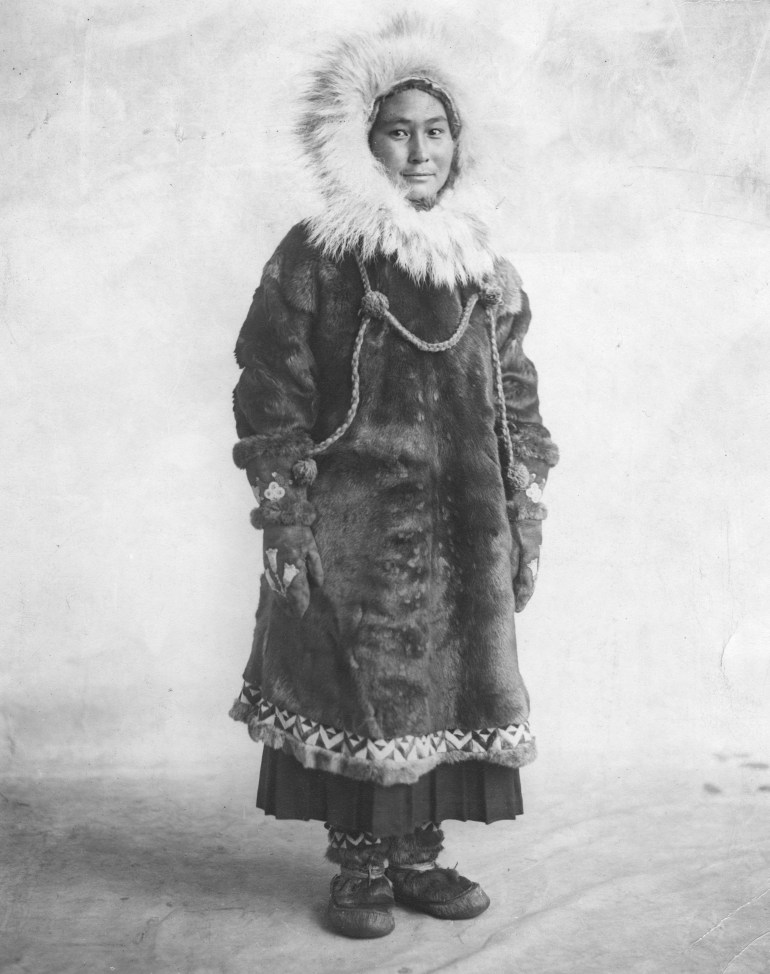 Ada Blackjack around the time of her expedition to Wrangel Island [Courtesy of Dartmouth College Library]
Ada Blackjack around the time of her expedition to Wrangel Island [Courtesy of Dartmouth College Library]After returning to Nome, Ada took Bennett out of hospital and to Seattle for treatment. She later remarried twice and had another son, named Billy. But when she herself contracted tuberculosis, Ada had to give up her sons once more, placing them in a children’s home in Seward, Alaska. Nine years passed before she was reunited with them again.
While Vilhjalmur and others profited from selling books, publishing diaries and lecturing about the tragic expedition, Ada returned to a life of poverty and struggled to find work. Although after moving to Nome with her sons in 1937, she did earn a living herding reindeer, hunting and trapping – skills she’d taught herself on Wrangel Island. Vilhjalmur had once promised her a share of the royalties from his book, which was based partly on her diary extracts, but she never received a dime.
With the money Ada received from the voyage, she was able to pay for Bennett’s medical treatment, but he never fully recovered from his illness and died from a stroke in 1972 at the age of 58. Ada died just more than a decade later from tuberculosis on May 29, 1983, aged 85, in a nursing home in Palmer, Alaska; she was buried by his side.
For years, Billy had campaigned for formal recognition by the State of Alaska of his mother’s bravery in the Arctic, determined that her name not be forgotten, like so many Inuit people who were hired to assist Arctic voyages and rarely credited for the critical roles they played.
It was not until a month after her death, that the Alaska State Legislature formally honoured Ada as a “true and courageous hero”.

No comments:
Post a Comment